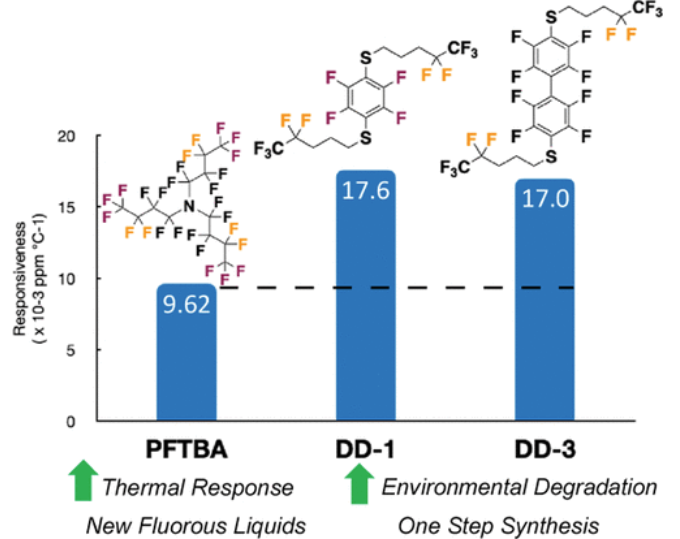Highly fluorinated compounds for magnetic resonance-based temperature sensing
Novel fluorinated molecules for temperature sensing by MRI thermometry.

Applications
- Non-invasive MRI temperature probe
- Temperature determination for in-vivo oximetry measurements
Key Benefits & Differentiators
- Increased temperature sensitivity: Approximate twofold increase in temperature sensitivity compared to proton-based MRIs
- Background-free: Improved signal to noise ratio due to the absence of naturally occurring mobile fluorine in the human body
- Scalable: Compounds are easily synthesized from cheap building blocks
- Liquid-phase: Allows for formulation of the fluorinated compounds into nanoemulsions or nanoparticles for increased sensitivity
Technology Overview
Hyperthermia is a promising, but experimental modality for the treatment of cancer. This treatment relies on precise thermal ablation of tumor cells while leaving healthy tissue unharmed. An accurate and non-invasive method to measure deep-tissue temperature changes is essential to ensure accurate and precise targeting of the thermal application. Currently, this measurement can be done via proton (1H) MRI-based thermometry because all tissue contains a substantial amount of water. However, this method is susceptible to error, low sensitivity in fatty tissues, and requires a reference for absolute temperature determination. To overcome these issues, fluorine (19F) MRI thermometry has been investigated as an alternative. This is an attractive method due to the absence of mobile fluorine in the human body and therefore a background-free spectrum can be acquired. However, there are concerns with the utility of current perfluorocarbon compounds for this application due to their low sensitivity and environmental persistence.
Researchers at the University of Minnesota have developed new highly fluorinated compounds for application in magnetic resonance-based temperature sensing. These compounds exhibit increased temperature responsiveness over previous generations of perfluorocarbon compounds and exhibit a twofold increase in sensitivity compared to proton-based MRIs. Moreover, they contain fewer alkyl fluorine groups than previous perfluorocarbon reagents and are less of an environmental concern because of their partial degradation in UV light. Since these compounds are a liquid at room temperature, they can be loaded into nanoparticles and used as a MRI-based temperature sensor. When fully developed these compounds have the potential to expand the use of hyperthermia to deeper organs that are currently not suitable for treatment with this method.
Phase of Development
TRL: 3-4Proof of concept has been demonstrated in an NMR magnet.
Desired Partnerships
This technology is now available for:- License
- Sponsored research
- Co-development
Please contact our office to share your business’ needs and learn more.
Researchers
- William Pomerantz, PhD McKnight Land-Grant Professor, McKnight Presidential Fellow, Department of Chemistry
-
swap_vertical_circlelibrary_booksReferences (1)
- Jiaqian Li, Thomas F. Mundhenke, Thomas G. Smith, William A. Arnold, and William C. K. Pomerantz (March 31, 2023), Fluorous Liquids for Magnetic Resonance-Based Thermometry with Enhanced Responsiveness and Environmental Degradation, Analytical Chemistry
-
swap_vertical_circlecloud_downloadSupporting documents (0)